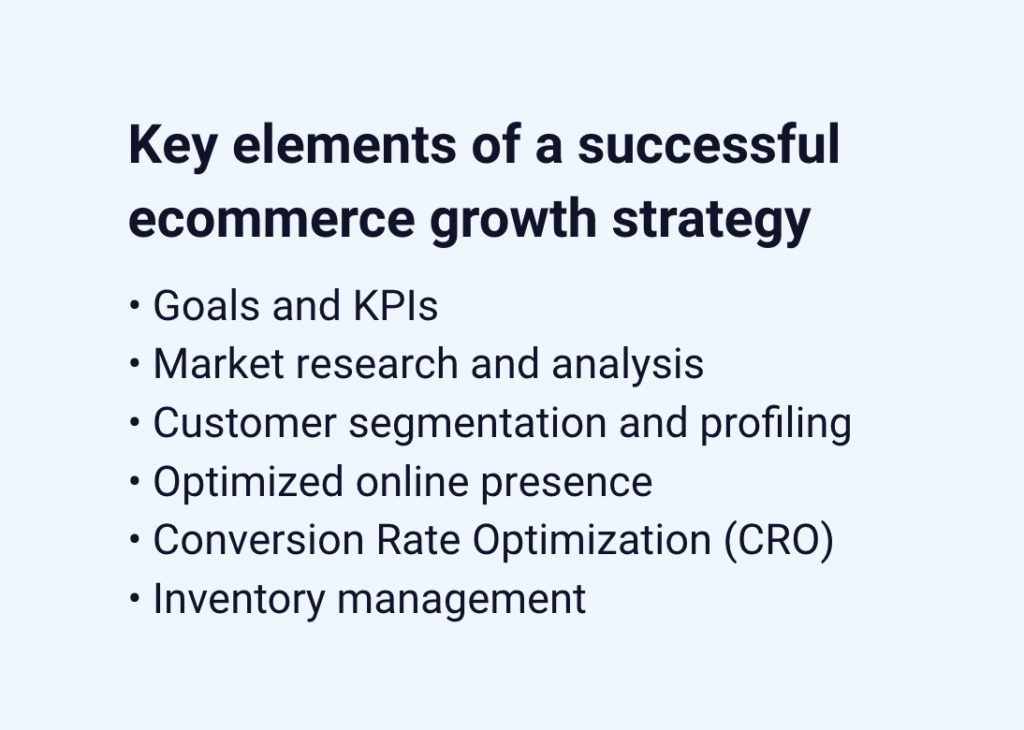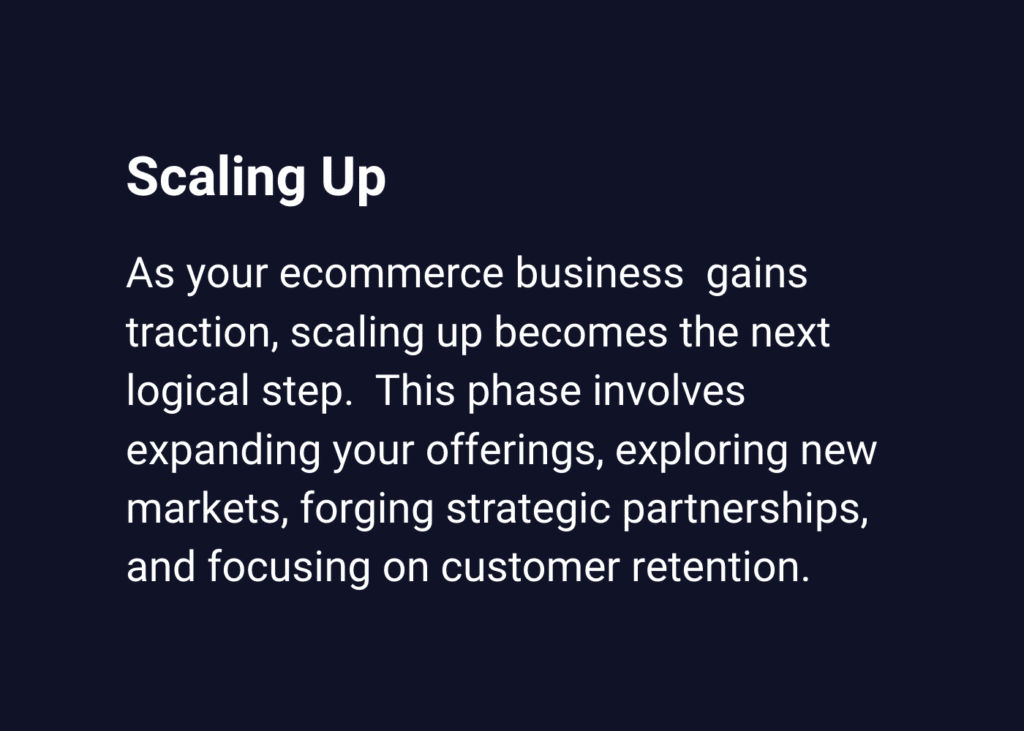How to develop an ecommerce growth strategy that delivers
Statistics show that 2.64 billion consumers will have completed at least one online purchase by the end of 2023.
And let’s face it, small businesses want a piece of this online action…
Welcome to the world of online selling, where the right ecommerce growth strategy can turn your small business into a thriving online powerhouse. This is your practical roadmap, tailored to help you navigate the complexities of the digital market.
From setting clear goals to optimizing your online presence, we’re here to break down the essentials. We’re not reinventing the wheel; we’re leveraging what works and applying it to your unique business landscape.
Ready to boost your revenue, expand your customer base, and take your business to new heights? Let’s dive into the nitty-gritty of developing an ecommerce growth strategy that truly delivers.
What is an ecommerce growth strategy?
A solid ecommerce growth strategy is your secret weapon in the online business world.
It’s the master plan that propels your small business from ‘just another online store’ to a dynamic, customer-focused titan.
At its core, it means expanding in three critical areas: boosting revenue, enlarging your customer base, and broadening your market footprint.
Let’s talk money first.
Increasing your revenue is more than just a numbers game. You need to know your audience, tailor your offerings, and hit the pricing sweet spot. You need to make every click, every page, and every product work harder for your bottom line.
Then there’s the crucial task of growing your customer base. This isn’t simply about reaching more people; it’s about reaching the right people, at the right time. You need to take a deep dive into who your customers are, what they want, and how they shop. This knowledge lets you tailor your approach, making your store not just a destination, but a favorite stop.
Lastly, expanding your market reach means casting your net wider. Whether it’s exploring new geographical territories or tapping into uncharted product niches, you need to look at the bigger picture and seize opportunities beyond your current horizon.
So, why is this golden trio of revenue, customers, and market expansion so crucial?
Well, in the dynamic dance of ecommerce, standing still is as good as moving backward, while a robust growth strategy keeps you nimble, proactive, and always a step ahead.
Key elements of a successful ecommerce growth strategy


Embarking on the journey to ecommerce growth is more than a venture; it’s a strategic mission critical to your business’s success.
With that in mind, let’s break down the core components that make this journey so fruitful…
Goals and KPIs
Setting goals and selecting KPIs is foundational in charting your ecommerce growth. These are the benchmarks that guide your every decision, not just targets.
Goals should be SMART – Specific, Measurable, Achievable, Relevant, and Time-bound – giving your strategy a clear direction.
For example, rather than simply aiming to increase sales, set a specific target like achieving a 20% increase in online sales over the next quarter. This specificity makes your goals more tangible and achievable.
KPIs, ranging from website traffic to customer lifetime value, act as signposts, telling you if you’re on track or need a course correction. They provide actionable data that helps you understand your business performance in real time.
For example, if your goal is to enhance customer engagement, relevant KPIs might include metrics like time spent on site, page views per visit, or social media engagement rates.
Regularly reviewing your KPIs helps you stay aligned with your strategic objectives, ensuring consistent progress towards your goals.
Market research and analysis
Thorough market research and analysis are your windows into the minds of your customers and the dynamics of your competitors.
By understanding customer preferences, behaviors, and trends, you can fine-tune your offerings to meet their needs more effectively. Tools like Google Analytics provide a wealth of information about your website visitors, from demographic data to browsing behaviors, helping you tailor your digital experience to match user expectations.
Customer feedback surveys are another helpful tool in your arsenal.
They offer direct insights from your customers, allowing you to hear their needs, preferences, and pain points. This feedback is invaluable for refining product features, adjusting pricing strategies, and improving customer service.
Additionally, analyzing competitors helps you understand their strengths and weaknesses, which can inform your unique value proposition. This comprehensive approach ensures that your business decisions are not only data-driven but also strategically targeted to exploit market gaps and capitalize on emerging trends.
Customer segmentation and profiling
Understanding the ‘who’ in your customer base is crucial for effective marketing.
Dissecting your market into manageable segments based on distinct characteristics like age, location, spending habits, or lifestyle choices is key. By doing so, you can craft marketing messages that resonate deeply with each segment.
For example, a segment of young urban professionals will probably respond better to tech-focused, trend-setting product lines, while suburban families might prioritize value and durability.
Tools like CRM (Customer Relationship Management) software are instrumental in this process. They help to collect and analyze customer data, enabling you to build detailed profiles. These profiles then reveal patterns and preferences within your customer base, guiding you in product development, marketing campaigns, and even customer service strategies.
Effective segmentation also allows for personalized marketing approaches, such as targeted email campaigns or tailored social media ads, significantly increasing the chances of engagement and conversion.
This precise approach ensures that every marketing effort is fine-tuned to the preferences of your audience, maximizing impact and ROI.
Marketing
Now, we can’t simply have just the one section for marketing, there are a few different avenues we need to explore…
Optimized online presence
Your online presence is your digital storefront, and optimizing it is key to attracting and retaining customers.
A well-crafted online presence is as important as the quality of your products or services, while a user-friendly website serves as the cornerstone of this presence.
Your website should be visually appealing, reflecting your brand’s aesthetics and values, while also being easy and quick to navigate. A cluttered or confusing website can deter potential customers, making a clean, intuitive design essential.
Equally important is mobile responsiveness.
Retail mobile commerce sales are set to account for 43.4% of total retail ecommerce sales in 2023, up from 41.8% in 2022. So, your website must perform seamlessly across all platforms. This enhances the user experience, potentially increasing engagement and sales.
A strong presence on relevant social media platforms extends your reach and builds community, too. Each platform offers unique ways to engage with your audience, from Instagram’s visual storytelling to Twitter’s concise updates. Utilizing these platforms effectively can create a loyal following and elevate your brand’s online presence.
SEO best practices are the final piece of the puzzle.
They ensure that your website is not just a beautiful façade but also easily discoverable by search engines. Using relevant keywords, creating quality content, and ensuring your site has a solid technical SEO foundation are all key SEO aspects.
You also need to regularly update your content to keep your site fresh and more likely to rank higher in search engine results, driving organic traffic to your site.
Conversion Rate Optimization (CRO)
CRO is about turning visitors into customers – analyzing how users interact with your website and making adjustments to enhance their experience and encourage purchases.
Techniques such as A/B testing, improving website speed, and refining the user interface can lead to higher conversion rates. Remember, small changes can often lead to significant improvements in how effectively your website converts visitors into loyal customers.
So, don’t change everything at once, start with a small change, analyze the results, and go forward from there.
Inventory management
Efficient inventory management is a balancing act that can significantly impact your ecommerce growth strategy.
You need the right products, in the right quantities, at the right time. This reduces holding costs and minimizes the risk of stockouts or overstocking.
Leveraging inventory management software can provide real-time insights into stock levels, helping you make informed decisions about reordering and inventory control. Good inventory management ensures that you’re able to meet customer demand promptly, maintaining customer satisfaction and loyalty.
Consider inventory forecasting as well, which provides you with the data needed to accurately predict what will be sold to whom, and when, so you’re always one step ahead of the game.
Scaling your ecommerce business


As your ecommerce business starts to gain traction, scaling up becomes the next logical step.
This phase involves expanding your offerings, exploring new markets, forging strategic partnerships, and focusing on customer retention to ensure sustainable growth.
Expanding product lines
Introducing new products is a pivotal growth strategy that hinges on diversification, a crucial aspect for mitigating risks and tapping into new market opportunities.
Diversification not only reduces reliance on a single product line but also introduces varied revenue streams, catering to different customer needs and preferences.
Conducting in-depth market research is key to identifying trends and consumer demands, ensuring that new product introductions are well-timed and market-relevant. You need to balance what your customers have come to expect with innovative offerings that can capture new interest. This balance is essential in maintaining brand consistency while exploring new avenues for growth.
When diversifying your product lines, consider how each new item aligns with and enhances your existing portfolio. While simply adding more products is great, you need to look at strategically expanding in a way that builds upon your brand’s strengths and values.
This approach to diversification helps create a robust product ecosystem that resonates with both existing and new customers, supporting sustained business growth.
Entering new markets
Think of expanding into new geographical regions as setting out on a grand adventure.
Once you’ve planted your flag, you need to immerse yourself in the local culture, understand what makes the market tick, and adapt your strategies accordingly. Conducting thorough market research is like having a friendly local guide, helping you navigate the unique consumer behaviors and preferences in these new territories.
Now, let’s talk about localization.
This goes far beyond simply translating your website; you need to speak your customers’ language, both literally and culturally.
Imagine trying to sell winter jackets in a tropical climate – it just doesn’t work. Adapting your marketing materials and product offerings to fit local needs and tastes is key here. And yes, there will be hurdles: think of logistics and regulatory compliance as the challenging terrain you need to cross.
But you don’t have to go at it alone.
Forming partnerships with local businesses or experts can be like finding an ally in unknown lands. They bring the map and compass – insights and knowledge of local regulations and consumer habits – that can be invaluable in navigating these new markets.
And let’s not forget the power of international ecommerce platforms. They’re like your trusty all-terrain vehicle, equipped to handle various aspects of localization and compliance, making your journey into new markets smoother and more efficient.
Partnerships and collaborations
Forming strategic partnerships in ecommerce is akin to assembling your very own dream team.
These alliances – whether with suppliers, influencers, or complementary brands – can open up a whole new realm of possibilities for you and your business. You can leverage each other’s skills and market presence to create a bigger impact than either could achieve alone.
For instance, consider an online fitness apparel store teaming up with a popular fitness app. This partnership can provide exclusive offers to app subscribers, giving the apparel brand exposure to a highly targeted audience.
Another example is an eco-friendly home goods store collaborating with a sustainability blogger. This type of collaboration can amplify the store’s message, resonate with a broader audience, and reinforce its commitment to environmental responsibility – it’s a win-win.
These partnerships are more than just tactical business moves; they help you to align with others who share your values and vision, creating a collaborative ecosystem that benefits all involved, and ultimately, the customers.
Customer retention strategies
Let’s face it, in the world of ecommerce, keeping your customers coming back is as crucial as making a great first impression (not to mention the fact it’s easier and cheaper to sell to existing customers than it is to attract new ones).
Long-term growth leans heavily on customer retention – turning a one-time buyer into a lifelong fan. This is where the magic of loyalty programs, savvy email marketing, and personalized experiences come into play.
Imagine a loyalty program that’s not just points and discounts, but an exclusive club your customers are excited to be part of. It makes them feel special and valued. Then, there’s email marketing, which is less about bombarding inboxes and more about sending the right message at the right time. Think birthday discounts, special previews, or a simple ‘we missed you’ message.
Personalized experiences are the cherry on top.
From product recommendations to personalized shopping experiences, showing your customers that you know them and care about their preferences ensures you stand out from the crowds.
Measuring and analyzing growth
Navigating the growth of your ecommerce business without tracking and analyzing key metrics is like driving with a blindfold – risky and directionless.
While measuring growth is partly about celebrating milestones, you need to understand the ‘why’ and ‘how’ behind those numbers. This understanding is crucial for making informed decisions and steering your business toward sustainable success.
As we mentioned earlier, KPIs are the compass that guides this journey. They aren’t arbitrary numbers; they’re the pulse of your business. Think of metrics like conversion rate, customer acquisition cost, and average order value. These KPIs offer a clear picture of what’s working and what’s not, providing insights that are vital for tweaking your strategies.
Platforms like Google Analytics, social media insights, and customer relationship management (CRM) systems offer a wealth of analytical data. They help you track customer behavior, website performance, and sales patterns. With these tools, you can spot trends, understand customer preferences, and even predict future buying behaviors.
Measuring and analyzing growth means that you are in tune with your business’s health. By using the insights gleaned from data, you can keep abreast of market trends and customer needs, ensuring your ecommerce venture not only grows but thrives.
Conclusion
That’s a wrap on our exploration of crafting a powerful ecommerce growth strategy, but remember: the right tactics and tools are crucial for turning your vision into reality. Every step, from insightful analytics to strategic marketing, shapes the path to a flourishing online business.
Now is the time to move from planning to action – see the difference Linnworks can make in your ecommerce journey. Integrate everything from inventory management to insightful analytics in a single platform, to streamline and empower your online business.
Ready to transform your ecommerce potential into success? Book a demo with Linnworks today. Discover how our platform can be the catalyst for growth, helping your business thrive.
